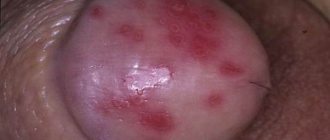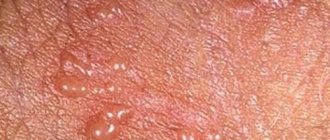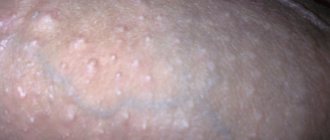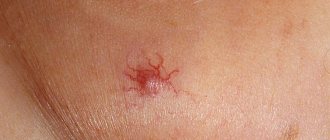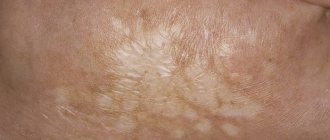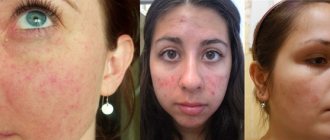If spots appear on the foreskin of men, there is a risk of infection in the body or the development of an allergic reaction. Normally, the skin of the penis is light brown in color (can vary from light to dark, depending on age and race) without pigmented areas. There are many diseases and other reasons that provoke the appearance of spots of different colors in the area of the foreskin and head of the penis. Most of them will require tests and a visual examination by a urologist.
What do blue spots on the head of the penis mean?
In most cases, blue spots are of vascular origin.
They are clotted blood.
There are several possibilities why this could happen:
- injury to the penis - a normal bruise has appeared, which will go away on its own after some time
- bleeding without injury - may indicate problems with blood clotting or increased fragility of blood vessels
- vasculitis – inflammation of blood vessels
- thrombophlebitis - inflammation of a vein and the appearance of a blood clot inside it
Less commonly, the cause is a skin lesion or rash.
This may be a nevus and some dermatological diseases.
Papillomas and condylomas
Papillomas and genital warts are benign neoplasms that occur when infected with papillomavirus. It is transmitted during sex (oral, vaginal, anal). The maximum incidence is recorded at the age of 15-25 years among sexually active persons.
The first signs of the disease appear several weeks or months after infection. Papillomas are pink, dome-shaped protrusions of skin. The growths may be flesh-colored, red, or brown. Genital warts with their growths resemble cauliflower.
Formations can occur on the shaft of the penis, foreskin, scrotum, perineal skin and around the anus. In most cases, their appearance is not accompanied by any symptoms; less often, a man may be bothered by itching and discomfort.
Treatment is complex and includes removal of tumors using local drugs or surgical microsurgery and systemic immunotherapy (Panavir, Interferon-alpha).
Rice. 1 – Multiple genital warts of the glans penis
Bruising on the penis
The most common cause of a blue spot on the penis is an ordinary bruise.
In the vast majority of cases, a person remembers the moment of injury.
Along with the bruise, pain and slight swelling appear.
Sometimes the person denies the injury.
But this does not exclude the fact that it actually took place.
It is likely that the person did not notice the damage to the penis.
After all, it could have happened on time:
- sex
- night sleep
- under the influence of alcohol, etc.
In addition, the moment of injury is not too painful.
Or a person’s attention is completely absorbed in a certain activity, and therefore does not notice the damage.
There are a lot of blood vessels on the penis.
They tear easily.
Blood leaks under the skin and a bruise forms.
It usually does not require treatment.
Within a few weeks, the bruising will disappear on its own.
Treatment methods
Therapy begins with diagnostic measures. If strange pigmentation appears on the penis, you should seek help from a dermatologist. An andrologist and urologist also consult on this issue. If the penis is bruised, a man should make an appointment with a urologist-surgeon or traumatologist.
Diagnostics consists of procedures such as:
- visual inspection;
- testing for diseases transmitted through sexual intercourse, the presence of fungi;
- examination for syphilis;
- hormonal background;
- scrapings if there is a risk of psoriasis.
Therapeutic tactics in the future depend on the “provocateurs” that provoked pigmentation on the genitals. For STIs and syphilis, intravenous antibiotics and antibacterial drugs are prescribed. If mycosis occurs, tablets, injections, and ointments are prescribed.
For herpes on the genitals, Acyclovir and suppositories are prescribed. Psoriasis is afraid of corticosteroids. Balanoposthitis resolves with topical antibacterial drugs. When the penis is bruised, the organ needs rest. If there is a tissue rupture, seek help from a surgeon.
Ignoring treatment: what will happen?
Since there are many provoking factors for the development of age spots, the consequences of refusing therapy will be different:
- Allergy. As soon as the allergen is eliminated, the symptoms will disappear on their own;
- If you have a sexually transmitted disease, then without treatment there is a high probability of infecting your partner and damaging internal organs (syphilis);
- Oncology. Without drugs, the pathology quickly leads to death;
- Skin rashes. You should not ignore it, otherwise the disease will become chronic. It is difficult to treat.
Blue spot due to a bruise on the penis
If a person gets a bruise on their penis and doesn't go to the doctor, it's just a bruise and nothing more.
But if he went to see a urologist, this is already a bruise of the external genitalia.
This is exactly the kind of entry a person will receive in their medical record.
The main causes are sports, falls on a hard object, or domestic fights.
Large hematomas are quite dangerous and always require a full examination.
Because a large bruise may hide a rupture of the tunica albuginea of the corpora cavernosa, damage to the corpus spongiosum or the urethra.
The most severe injuries occur during an erection.
If it is applied when the penis is not erect, it is usually limited to only a subcutaneous hematoma.
Signs and manifestations
There are red spots on the foreskin without itching or burning, which are asymptomatic.
But more often patients complain of the following unpleasant sensations:
- Pain occurring during or after urination.
- Swelling in the genital area, which does not allow the head to be fully exposed.
- Erectile dysfunction, decreased potency.
- Severe irritation of the foreskin, accompanied by itching in this area.
A man can also pay attention to the appearance of nonspecific discharge; the secret is:
- curdled, reminiscent in nature of yogurt flakes;
- mucous or purulent, with an unpleasant odor, mixed with blood.
There are also cloudy, copious discharges, which also indicate the presence of inflammation in the tissues or organs of the genitourinary system. Often, against the background of such a phenomenon, a person’s body temperature rises and there are signs of intoxication.
If you are concerned about redness without itching or pain, then it may be:
- about dermatitis;
- contact of the body with aggressive substances;
- about a violation of the microflora of the mucous membrane of the intestine.
A change in skin color in the intimate area, combined with itching, should also be regarded as a manifestation of an allergic reaction.
Contact with substances causes a hypersensitivity reaction in the body, which leads to unpleasant sensations.
It is difficult to independently determine what is considered normal and what is pathology. Despite the fact that the problem is delicate, its solution is impossible without the participation of a doctor. You will have to contact a urologist and venereologist.
Spots on the penis with hemorrhagic vasculitis
Systemic vasculitis may be accompanied by spontaneous hemorrhages under the skin.
In this case, blue spots appear even without injury.
But they form not only on the penis, but throughout the body.
The disease is characterized by a hemorrhagic rash.
Initially, the elements are small and red.
But then they get larger and turn blue.
Over time, the elements fade and disappear.
Many patients simultaneously develop articular syndrome.
The gastrointestinal tract and other organs are often involved.
Preventive measures
Urologists recommend that if pigmented rashes occur on the penis, proper and regular hygiene is observed. This concept refers to keeping the penis, scrotum and testicles clean. It is also important to be selective in your sexual relationships. Linen should be made from natural materials and fit properly.
In any case, it is worth remembering that age spots on the penis are a pathology. It can only be eliminated with the help of a qualified doctor. Not only a venereologist understands such issues, but also a dermatologist and a surgeon.
Not every man can easily talk about his problem in a regular clinic. It is not forbidden to show a mark on a member in an anonymous office or a private hospital. It is worth remembering that specialized doctors face similar problems every day, so you should not be ashamed of them.
Conclusion
It is unnecessary to ignore spots on the genitals, since any of them can signal a serious illness. It is also not worth delaying treatment, otherwise there is a risk of developing a dangerous pathology.
It is recommended to gather your courage and show the doctor all the areas on the genitals that make you panic. He will tell you how to get rid of them correctly.
Lichen planus on the penis
Although lichen is called lichen ruber, the rash may actually be lilac, purple, or blue.
The disease is of unknown origin.
It develops acutely.
The rash appears within a few days.
Itching is common.
The rash looks like small papules a few millimeters in diameter.
Less commonly, these are thick hyperpigmented plaques.
Having seen blue spots on the head of the penis, the doctor will examine the oral cavity and nasopharynx.
Because with a 50% probability elements of the rash will also be detected here.
Malignant neoplasms and blue spots on the penis
When a blue spot appears, you should not think about a malignant process in the first place.
The genital organs are a fairly rare location for such tumors.
For many of them, ultraviolet radiation is a risk factor.
And the penis is not one of those areas of the skin that is often exposed to the sun.
But still, sometimes skin cancer appears in this area, and this option is also worth remembering.
In this case, the blue spot does not appear instantly, as with hemorrhage, but gradually.
It increases in size and becomes voluminous.
Let's look at the main malignant skin tumors that may appear blue.
✔ Superficial spreading melanoma
The most common malignant tumor that grows from melanocytes.
The course is relatively favorable.
The neoplasm immediately grows horizontally, and only after a long time does it enter the vertical growth phase.
Color may vary.
Quite often the formation is blue.
It rarely forms on the penis, but such cases do occur.
Typically, men notice the spot when it reaches 0.5 cm or more.
Less commonly, pathology is diagnosed when it has a diameter of more than 1 cm.
The outline of the blue spot is irregular and has indentations.
The boundaries are clear.
The color is uneven.
Most areas may be blue, but they fade into black, gray, brown.
In some places there may be areas where there is no pigment.
✔ Desmoplastic melanoma
This is a rare tumor.
It is found mainly in areas of the skin exposed to ultraviolet radiation.
In 85% of cases it is a tumor of the head or neck.
Occasionally it appears in areas hidden from the sun, including the penis.
Many tumors do not contain pigment.
But the elements of the rash that appear are still pigmented.
At an early stage, an unevenly colored spot forms on the skin of the penis.
Upon examination, you can see many small blue nodules.
If the pigment is formed, then over time a blue node or gray node forms on the penis.
This is the result of melanocyte deposition.
✔ Nodular melanoma
It accounts for about 15% of all melanoma cases.
A very dangerous disease, as there is no horizontal growth phase.
When a node appears, its vertical growth immediately begins.
A dark blue spot appears on the penis.
It is evenly colored.
Quite quickly, the spot increases in size and turns into a knot.
Often nodular melanoma grows from a pigmented nevus.
If there is a mole on the penis, a man should monitor its color and shape.
If the formation changes, you should see a doctor.
✔ Acral lentiginous melanoma
A special form of melanoma, which most often appears on the penis among all melanocytic tumors.
It is rare in white people.
But among the Negroid and Asian races it reaches 50-70% of all melanomas.
Men get sick 3 times more often than women.
The tumor grows very slowly.
In the radial growth phase, it looks like a blue spot.
The color is uneven.
The shape is irregular, but the boundaries are clear.
✔ Basal cell carcinoma
One of the three main malignant skin tumors, along with melanoma and squamous cell carcinoma.
It occurs more often than all other formations.
The disease has a relatively benign course and rarely metastasizes.
The exception is undifferentiated cancer caused by radiation.
There are several clinical forms of basal cell carcinoma.
Sometimes it looks like a blue knot.
The disease is characterized by deep tissue invasion.
Prevention measures
The best preventive measures include:
- Regular (at least 2 times a year) intake of vitamin and mineral complexes that help strengthen the immune system.
- Strict adherence to the rules of personal hygiene, including daily showering using soft hygiene products (having a neutral pH level) and a mandatory change of underwear, which must be made of soft natural fabrics.
- Maintaining a healthy lifestyle.
- Complete cessation of bad habits
- Using condoms when having sex with a casual partner.
- Annual medical examination and scheduled diagnostic procedures with tests.
- Use of medications in strict accordance with the dosage and doctor’s recommendations.
Tests for a blue spot on the penis
Patients often come to the pharmacy and ask what to apply on a blue spot to make it disappear.
It is likely that in such a situation the pharmacist will indeed offer you some kind of ointment.
After all, it is important for him to sell the goods and make money for the pharmacy.
But the probability of guessing with the drug is not too high.
We have already found out that there can be quite a few reasons for the appearance of a blue spot or several spots on the penis.
They are all completely different in origin.
In addition, stains often cannot be removed using conservative methods.
But they can be eliminated using laser or other minimally invasive methods.
Some causes of blue spots are dangerous and threaten your health.
For example, they may indicate impaired blood clotting or incipient cancer.
Therefore, if you are not sure, then it is a bruise, it is better to consult a doctor and get examined.
It is also worth going to the doctor if the bruise is large and painful.
Because serious damage to the penis is possible.
If left untreated, in the long term after injury, severe complications occur, such as scarring of the urethra or deformation of the penis.
Erectile dysfunction, infectious complications, etc. may develop.
In such a situation, you need to consult a urologist or dermatovenerologist.
It will conduct an examination and dermatoscopy.
Examine the spot under a Wood's lamp.
Then he will take the necessary tests.
After injury, examination can be performed using ultrasound.
It is important to assess the extent of damage to the penis.
If suspicious spots with clear boundaries that are not bruises appear on the skin, their origin can be assumed using dermatoscopy.
This is an examination of the skin under magnification.
Tests are often required to verify the diagnosis.
A scraping and examination of the cytological picture is carried out.
If the doctor suspects that it may be malignant, it must be removed.
Then the removed node is sent for histological examination.
A conclusion comes from the laboratory that allows you to accurately determine what it is: nevus, hemangioma, melanoma or other formation.
If the process turns out to be malignant, this will affect further treatment.
A repeat operation may be performed with wider removal of the skin in the area where the pathological focus is located.
Systemic diseases can also cause blue spots to appear.
It is likely that bleeding under the skin of the penis is due to decreased blood clotting.
It can be caused by a number of diseases.
Therefore, a coagulogram is performed.
During this test, the doctor checks how quickly the blood clots.
A complete blood test allows you to understand whether there are enough platelets in the blood.
If necessary, a study is carried out to determine the content of various blood clotting factors.
Once the cause of the blue spots has been determined, the doctor will prescribe treatment.
Diagnostic measures
Looking at the photo, it is impossible to prescribe treatment and make a diagnosis; for this you will have to undergo a number of diagnostic measures:
- It is worth taking a smear from the urethra for microflora, this will help to recognize and identify the pathogen;
- you need to do an ultrasound of the organs of the reproductive and urinary system;
- donate blood for various tests that can help determine the presence of sexually transmitted diseases.
Less commonly, other procedures are required, which are prescribed and selected on an individual basis.
